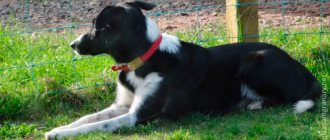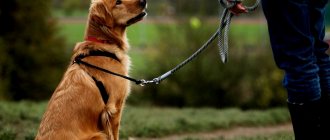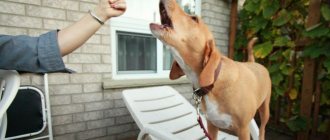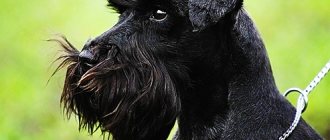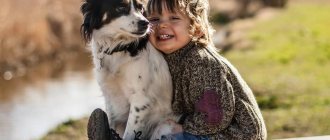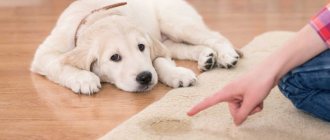What to do if a dog attacks? This is a question many people ask themselves. Dogs, of course, are our friends, partners and charges, but they, like people, are different. A dog’s aggressive behavior can be provoked by various factors, including humans, so everyone needs to learn the rules of safe living together.
What to do if a dog attacks
Basics of conflict-free interaction
To minimize the likelihood of a dog attacking a person, it is necessary to behave politely. This concept applies not only to the relationship of people to each other, but also to the relationship of people to animals. Dogs are symbionts of humans. This means that we have been in a state of mutually beneficial cooperation for many thousands of years.
Mutually beneficial cooperation for common pleasure
This symbiosis, of course, is fixed at the genetic level. Dogs strive to live with a person as in their own pack, and people cannot do without dogs, both in the family and in various sectors of public life. The problem of interaction between people and dogs is that the latter, like the former, divide objects into their own and those of others. You need to protect your own from strangers. This is the source of aggression on both sides of the interaction. All animals have a set of behavioral programs, that is, instincts. Humans also have them, so their behavior may often seem illogical. We must not forget that dogs are herd hunters. They tend to gather in flocks and pursue fleeing prey. For this reason, a running person for a pack or an aggressive dog is a provocation of persecution.
A dog recognizes a person's intentions by smell.
All animals have their own language of communication. Information in canines is transmitted by body movements, voice and, of course, smells. Moreover, unlike us, they are primarily guided by smells, then by body movements. Voice signals are just an auxiliary way of transmitting information.
Dogs, of course, learn about a person’s intentions by smell. The stronger the smell, the more it attracts attention and causes alertness, because in the world of animals it is a sign of fear and aggression. A person with a strong chemical smell (perfume, washing powder, soap, gasoline, alcohol, nicotine) always provokes aggression in a dog because it smells unnatural.
It should be remembered that most dogs treat people well. However, they have fear, despair and a willingness to defend their lives, their master and his property. The source of danger is dogs that are frightened, killed, stray and abandoned.
Where to go if bitten?
If you are bitten by a stray dog, you need to wash the wound yourself with water and soap and seek medical attention as soon as possible.
An animal can be infected with rabies, in which case, without timely vaccination, the bitten person faces death. If an examination can be ordered when a domestic dog is bitten, then a stray dog will most likely not be caught, so the doctor must prescribe injections in any case. If previously 40 injections were given to completely eliminate the disease, now only six are enough. They are made according to a certain scheme for 90 days.
Cases of dog attacks on humans must also be reported to the relevant services. In Moscow and the Moscow region there is a wild animal trapping service of the State Unitary Enterprise "SOJ", 24-hour telephone number - +7 (495) 781-00-08. The organization accepts applications for the capture and sterilization of dogs, including aggressive ones.
The application must be submitted by a fauna specialist, so a written application to the management company or homeowners association will be required from the residents of the house near which stray animals live.
Which dogs are the most dangerous?
There are the following dog danger options (arranged in order of importance):
- flock;
- lonely animal;
- on site security;
- with the owner;
- at home.
The flock acts harmoniously, each individual stimulates the others. This is where their increased danger lies. However, this does not mean that there will necessarily be killers in the pack. Most often, such aggressiveness is feigned. The dogs are just trying to scare a stranger, and at the same time conduct exercises and find out which of them is cooler.
The flock acts harmoniously, each individual stimulates the others
Packs are formed by completely stray dogs that live on their own, as well as by fed ones. The latter are divided into two parts - some simply take advantage of people’s kindness, others also protect the object for food, a booth and patronage. Individuals who are not specifically involved in these duties also defend their territory, but their aggression is most often directed at their fellow creatures.
It is believed that the most dangerous flocks are the well-fed guards who run both inside and outside the facility. Such a flock protects a large territory. This control of approaches to the object creates the illusion of special aggressiveness. However, mercenary dogs are not as dangerous as they seem. They bark and run around a lot, demonstrating their fighting intentions in every possible way. Such active behavior is a sign of official zeal, and not bloodthirsty aggression. Such a flock calms down very much immediately after the person leaves or a guard appears giving commands.
Packs of stray dogs living their lives often do not pay attention to a person, unless, of course, he pays attention to them. They bark little, are busy searching for food, and come into conflict only with their own kind, defending territory and spheres of influence.
Packs of stray dogs often ignore humans
The problem only appears if the flocks are led by individuals who have suffered greatly from humans. Revenge, resentment and bitterness are characteristic of all intelligent animals.
Specially trained service dogs guarding a fenced facility are dangerous only in that area. They clearly understand what needs to be done and where. However, this does not mean that everyone who enters the territory protected by dogs will be torn to pieces. Guard dogs are not killers. Their task is to stop the person and wait for their owner. So, with the right behavior, you can keep your life and health intact.
For some reason, dogs walking with their owners most often cause fear in passers-by. Perhaps this is due to the fact that such individuals are ready to protect their owner. In this case, the situation entirely depends on the behavior of people and the upbringing of the dog.
A dog walks with its owner, but they are afraid of it
Animals at home are, of course, dangerous to strangers who come with evil intentions. Dogs perfectly sense a person’s mood. They can calmly let one through and even release them, while they will scare the other and maybe even bite. Such dogs are at the bottom of our rating of dangerous individuals and conditions, because conflicts in this case are easy to avoid; simply not intruding into someone else’s home is enough.
How to stop a dog from lunging at people?
It is impossible to significantly reduce the feeling of fear experienced by a dog before strangers approaching him and their touches. Therefore, the recommendations are aimed at how to avoid aggression.
Eliminating problematic situations
The dog must be put on a leash when there are other people or certain types of people nearby who cause aggression (children, people jogging). This will not only ensure the safety of strangers, but will also force the dog to be close enough to the owner so that he can intervene if necessary and suppress the manifestation of aggression.
Since such dogs do not just try to bite a person, eliminating problematic situations for the owner in most cases means:
- do not visit crowded places, for example, restaurants, where the dog’s proximity to strangers is inevitable,
- do not leave the dog alone in places where someone can approach and pet it (for example, at the door),
- Inform guests, children, and owners of other pets that touching the dog is dangerous.
If a dog reacts aggressively to guests, it must be isolated. Dog owners often express concerns that locking the dog in another room while the aunt is present in the house will only increase the animal's aggressiveness or damage its psyche. Although isolation in a separate room is usually in close temporal connection with the arrival of guests and therefore increases antipathy (and thus aggression), it is the lesser evil. This method will not harm the dog’s psyche, so it should be recommended to the owner.
Training obedience using conventional methods
If a dog has learned to follow the 4 basic commands well (“come”, “place”, “sit”, “stay”), the owner can control the dog’s movements in certain potentially problematic situations, which often allows problems to be avoided entirely.
The dog must be muzzled at all times when in close quarters, such as in a restaurant, surrounded by a large number of small children, or on public transport, where close physical contact with strangers is inevitable.
It is not possible to completely eliminate a dog's deep distrust, fear or antipathy towards strangers, so it is necessary to constantly warn strangers who come to VISIT OR approach the DOG on the street that they should not touch, pet or get too close to the dog without warning. approach her.
It is necessary to perform obedience exercises with your dog every day at home and/or work with an instructor. This will allow the owner to better control the dog in problematic situations.
It is necessary to stop the practice of unintentionally encouraging aggression against strangers (in response to growling/attempts to bite, the owner pets the dog, talks to it, picks it up, or tries to distract it). Although these methods provide short-term success, they only make the problem worse in the long term.
It is necessary to strictly scold the dog every time it growls or tries to bite a person (it is advisable to use it in cases where a positive effect on the threshold of inhibition of aggression can be expected without increasing the feeling of fear of strangers).
Dogs can bite while playing
If the problem is not so significant, the dog only sometimes shows fear of strangers and reacts aggressively to them:
- It is necessary to generously reward the dog for good behavior (lack of fear or aggression). To do this, pet, praise the dog and give it a treat in the presence of a person who is the type of person against whom aggression is usually directed. In other situations, do not give treats.
- If a dog behaves fearfully but does not show aggression, it should be ignored, that is, when fear is shown, the dog is completely deprived of attention.
- A sharp shout at a dog in case of bad behavior is a completely natural reaction of the owner. If a dog growls at people or tries to bite, it should be scolded.
Strengthening master's superiority
Measures aimed at enhancing the superiority of the owner are very important. For example, a dog; prone to conflict behavior, who approaches strangers in a friendly manner and then bites when someone tries to pet her, needs to be kept away from them. However, this is difficult for owners of wayward dogs who seek to subjugate a person to their will and practically do not listen to him.
Working on the cause of aggression - how should a person behave?
Each time approaching the dog, this person stops at a certain distance from it, and at this time the owner rewards the animal with a treat for non-aggressive behavior. The person is asked to stop at the same distance each time until the dog learns to respond without signs of fear or displeasure. During this training process, as the dog becomes accustomed to remaining calm, the distance is gradually reduced until the person appears very close to the dog and can gently touch and even pet it. With proper organization, the dog does not feel fear during the entire exercise.
It is most advisable to use this method if the dog is only afraid of a certain person or a certain type of person, for example, 5-10 year old blonde girls. In this case, an exercise involving fair-haired girls of this age may cause a projection of sensations onto other children similar to them. However, if the dog is afraid of any strangers or any strange men, this method has less chance of success. It is possible that during training the fear of certain individuals will decrease, but projection onto other strangers or unfamiliar men is unlikely.
The second method of correcting behavior is overexcitation. This method can be used when it is possible for the dog to have more or less constant contact for several hours with a certain type of person of whom he is afraid. For example, if a dog reacts fearfully to large crowds of people, the owner may be with the dog every day (muzzled) on a busy street where hundreds of strangers would pass by every hour. The main condition for the correct use of this method is that the dog’s owner stays in such a place for a long enough time to significantly reduce the fear experienced by the dog, which may take several hours (you can read more about the method of overexcitation and the features of its use in Chapter 15).
In general, behavior correction methods can be quite effective in individual cases of self-defense aggression towards strangers. However, these methods take too much time to put into practice. It is difficult for dog owners to implement them, since sometimes they have to involve people unfamiliar to the dog. Often these methods cannot guarantee that the dog will not pose a danger to people it encounters in the future. In short, in some cases these methods may be useful. However, in most cases they do not provide a truly effective solution to the problem.
How to recognize an aggressive dog
An individual barking at a person is not always dangerous for him. A lot of noise and fuss is made by those animals that try to avoid military clashes. Noise is produced in order to:
- to frighten;
- gain courage;
- warn everyone else about the danger;
- attract attention.
Ultimately, such an individual achieves its goal - the owner or other dogs pay attention, and the person, not wanting to tempt fate, leaves.
Table 1. A dog’s readiness for certain actions can be recognized by the following signs.
| Part of the body | Uncertainty | Voltage | Ready to attack |
| Tail | Wags or hides between legs | Hangs along your legs | sticks up |
| Ears | Pressed down and/or pulled back | Pointed upward or forward | Directed upward or forward, can be retracted |
| Eyes | Averted to the side or down, squinted, half-closed | Fully open, gaze directed at the person’s face | Open or slightly squinted, intense gaze, directed through the person or at a specific part of him |
| Mouth | Closed or open with tongue hanging out | Can be open or closed, but the tongue is matched | Teeth exposed, tongue tucked |
| Sounds | Loud barking, but yapping type, no sounds | Silence or hoarse and continuous barking | Growling, restrained or threatening |
| Body | Not tense, slightly lowered due to half-bent paws | Muscles tense, paws straightened | The body is like a taut string, the hind legs are slightly bent |
| Appearance | There are inconsistencies in the position of different organs - a wagging tail with a loud bark and a fixed gaze | With the general composure of the body, elements of uncertainty can be observed | The body is tense, all the signs are clear, there are no contradictions |
These are signs characteristic of the average dog. However, they do not always appear all at once. Each individual prepares for battle in its own way, depending on the breed, age, gender, and upbringing temperament. In individuals that are unable to express emotions with their tail or ears, the picture is blurred.
As for the pack, what you should be afraid of is not a crowd of barking and scurrying dogs, but a close-knit group that surrounds a person on all sides in an organized manner. However, this situation is not hopeless; with the right behavior, it is possible to “agree” with a detachment of organized warriors.
Usually what causes shock and horror is some large shepherd dog standing motionless, but watching your every move. This is the behavior of a professional. Such a dog is not dangerous, but only as long as you stand, sit or lie motionless. However, it is always easier to come to an agreement with a professional than with a pack of well-fed mercenaries.
Ready to attack
When a dog attacks: Self-defense, protection of 3 persons, protection of children
Each of us has at least once in our lives encountered dog aggression in one form or another. Moreover, nowadays there are a lot of fighting dogs in private hands. What to do if a dog attacks you or your loved ones?
The main reason for the inability to effectively resist a dog is the painful shock from the bite. All the dog’s actions are intuitively aimed at creating it and strengthening it if necessary.
Loss of blood or injury to the adductor muscles, bones and ligaments from the first attack on an adult is the exception, and pain is the rule. You have to be psychologically prepared for wounds, for the sight of your blood (which makes many “float”, even if they have the strength to fight). Know that if there is no weapon, the dog will still bite - to one degree or another. But if you fight and win, the bites and mental damage will be much less.
Pain can be different - strong, very strong, sharp, dull, local, general, tolerable, unbearable, painful shock. It is impossible to endure (ignore) unbearable pain. There is a specific “combat” phase when the motor response to pain is switched off. This is an exclusively psychophysiological phenomenon - this sometimes happens to people during natural or man-made disasters, car accidents, etc. This is an exclusively autonomous mechanism and it is not regulated by volitional effort in the vast majority of “ordinary” people.
The content of the article
Fight with a dog
You need to try not to let the dog grab onto the joint - it will gnaw it in a few seconds (have you seen how dogs chew bones with a delicious crunch?). And we're not just talking about hand joints. One man who fell in such a fight was chewed off his knee joint by a dog in 5 seconds. Then they barely pumped him out. And restoring joints is almost impossible (or very expensive).
The dog’s tactics are as follows: it grabs, and then begins to tear: shake its head or pull it towards itself. This action—the jerk—is the most painful. Therefore, trying to hold it on your hand to strike is stupid. It is useless to resist, it will only aggravate the injuries.
When attacking the hand , do not pull it out, as an option - the hand is in the mouth, the dog must be thrown to one side and pressed on the neck with your knee. This will cause her to release her grip. But you need to hold it firmly with your knees with your whole body. With your second hand you can hammer into the skull, in the area of the jaw joint. But you can only hit if your striking hand is free, that is, for sure. Otherwise, when hitting, you can weaken the grip and the dog will break free. You are unlikely to knock her out with a blow, but you will force her to loosen or release her grip.
Another option is to push the captured hand deeper into the mouth, and grab the skin behind the ear with the other, twist it, and pull it towards you (at the same time as pushing the other forearm into the throat). In this case, you need to kick the dog in the groin (it doesn’t matter whether it’s a male or a female).
You can deliver short blows to the nose - but you still need to hit it (you need training with the dog in a game form).
If she abandoned you, escaped, but attacks again, take it into your hand again. At this time, either the owner will come running, or someone will help. Another option is a finger strike in the eye. Let's make a reservation again - this technique is effective, but you need to be prepared for it. Everyone likes to argue that you can attack the eyes, in practice, poking a living creature in the eye is psychologically difficult because of the cruelty and sometimes irreversible consequences (the blow must be truly damaging, dogs have a lower pain threshold, but the eyes are important sensory organs, she will stop attacking , protecting them only in case of vision failure). We must be prepared for this.
Previously, the inhabitants of the taiga were taught that if a wolf attacks and grabs your hand, you need to grab it with the captured hand by the root of the tongue in its mouth, call for help, and hold it like that until help arrives. One woman led a wolf to a woodpile near her house and, taking an ax with her free hand, cut off his head. Of course, he damaged her hand, but she remained alive.
Attack to the body . Two options, one end. In winter, the dog grabs, clings to outer clothing, usually breaks off during a struggle, and again carries out the grip on the limb. In the summer it bites on the body and again seizes a limb. Understand that in order to fight, she must grab you with her mouth, the fuller the better for her (as they taught). This is the feeling she will seek if the first attack is unsuccessful. During a body attack, you need to protect the areas of the face, abdomen, groin and armpits. Face (no comments), groin and armpits - injuries to these areas are dangerous due to large loss of blood (large blood vessels are located there), and you may not be able to wait for an ambulance. Can be held by the stomach, it is very difficult to resist (severe pain). But this still applies more to specially trained dogs. Ordinary amateur training is not so effective and, as a rule, does not teach real combat with a person with real resistance. Therefore, your defensive actions must be uncompromising; in this case, it is better to overdo it. Because a dog can actually injure and kill a person. Often, when encountering serious resistance during an attack, an ordinary dog does not re-attack, runs around barking, but does not bite anymore - it is not trained.
When a dog jumps , you can “leave the line of attack” - that is, jump to the side, and the dog will fly past. But this again requires trained reactions and movements.
How to remove a dog from another person, especially if it has grabbed a child
We run up from behind, act quickly, with our left hand we grab the collar or the skin from above and fix it, if possible, without allowing him to move his head in order to reduce damage. We grab it with a twist. With the right hand we grab the groin and pull it up while shouting “Fu!” Pull strongly upward until the hind legs lift off the ground. You need to force the jaws to open by applying pain to the groin. If you pull the dog away from the victim, the wounds will be lacerated. If it’s a male, everything is clear; if it’s a female, we grab everything that’s there, pull it hard and also pull. Bitches, as a rule, react more sharply to touch in the groin area. I don't recommend grabbing the tail. Yes, the place is painful, but the dog will easily switch to you and you will not be able to do anything.
Further. Keep in mind - 99 percent that the dog will switch to you. How can this be made difficult? Depends on the location of the fight. You have to think quickly, try to throw it over the fence, if there is one, throw it against a tree, downhill, into the bushes. That is, to use the terrain in such a way as to gain distance during a possible attack in order to meet it with dignity. When attacking, we meet with our foot or give up our hand. You can use a stick or pipe (if you have one). Hit him on the back more than once. Let me remind you: a dog is a beast, animals do not fight to the death (except for pit bulls). With real resistance, when its life is in danger, the dog will stop aggression.
What not to do when attacked by a dog
to drive away a dog with your feet , but some work not only on the arms, but also on the legs.
About interrupting the spine . Firstly, the dog is fast and difficult to hit. We must soberly assess our capabilities.
to choke . But, if without a noose, then, firstly, it is very problematic to grab a dog by the throat, and secondly, it is very difficult to restrain, not to mention suffocation, but at this time she wants to bite, she won’t do it without biting , allow yourself to be suffocated. In general, there is a high probability that you will be bitten. If you grab him near the head, wrap your legs around him and choke him, squeezing your chest - this is more realistic, but the problem is catching him and holding him while you choke him like that. But the last thing to do is choke. There is also an option to put your hand further into the mouth, cutting off the oxygen. But how realistic is this?
Hitting a dog on the head , body, or paws is almost useless (unless you are a bone breaker). This will most likely make the dog even more angry. Hitting the eyes is also doubtful.
There are stories of someone breaking or dislocating the paw of an attacking dog, but how to do this? Look, they'll bite, too. And will it stop? A dog can run very well on three legs, and will he feel pain on adrenaline?
It is theoretically possible to meet a dog with a kick, but you still have to hit it.
Summary
Theoretically, you can fight off a dog with your bare hands, but you need to be prepared that you will be bitten. But practically, depending on your luck...
From the book by M. Didenko, “Self-defense without weapons“
How to Avoid a Dog Attack
Sometimes people challenge the dog with their behavior, provoking it to attack. To prevent this from happening, the following actions are prohibited.
- Wave your arms and shout loudly. Of course, some individuals can be frightened in this way, but the most determined of them, and perhaps the nervous ones, will perceive this as an attack. Anticipating a human attack, the animal will prefer to attack first.
- Give standard prohibiting commands. The fact is that commands like “fu” or “no” should only be given by the owners. A properly trained dog perceives such commands from a stranger as a challenge and incorrect behavior. It is possible that the animal will react to the command reflexively, but this will be the first reaction, after which a second reaction may occur, opposite to the first.
- Turn your back and run away. This is a universal rule for interacting with any predator. The fact is that there is an instinct to pursue the victim from behind, because there may be teeth, horns and hooves in front. In addition, there are no eyes at the back, so the back facing the predator is a demonstration of weakness, defenselessness and vulnerability. If the predator is determined, then the fleeing person triggers the instinct of pursuit.
- Look into your eyes. This ban is controversial. If you look directly into the eyes of an animal from above, then in the language of the pack this will mean a claim to leadership, suppression of an opponent. If you are facing a self-confident animal who does not tolerate superiority, then such a challenge can cost you dearly. A nervous individual, not confident in himself, may become embarrassed, confused, and perhaps leave from such impudence of a person. The choice of behavior strategy depends on a person’s self-confidence.
- Talk. There are also disagreements on this matter. Some people believe that you need to talk to the animal kindly, it will calm down and go away. However, for the dogs themselves, barking, that is, the sound, means aggression. Dogs often react the same way to a person speaking in silence, especially if it happens loudly. On the other hand, the heart-rending female squeal sent even bears and tigers fleeing.
Thus, all prohibitions are divided into absolute and relative. The first category includes prohibitions on turning your back, running away, loud screams, and active gestures. All other prohibitions may be violated depending on the situation.
Situation No. 5. The dog is preparing to attack
If a dog is growling gutturally, and its ears are pressed to its head, it is about to lunge. In this case, you need to immediately cover vulnerable parts of the body: chin and neck. To do this, pull your head into your shoulders, tuck your chin and clench your fingers into a fist. Take a stable position, facing the animal, but without looking into its eyes.
The fact is that stray animals do not attack a person in the face (for this the dog needs to be specially trained). But under no circumstances should you look the dog in the eye, trying to show it who is boss. She will perceive a direct gaze as a call to attack.
Usually dogs attack first in the forearm or lower leg. Therefore, take off your outer clothing and wrap it around your forearm. If you are right-handed, then the hand you should use to bite is your left; for left-handers, on the contrary, it is your right. This will free up your dominant hand to hit or grab the aggressive animal when biting.
What to do if attacked by a lone dog
All situations associated with animal attacks usually develop rapidly, without giving the parties to the conflict interaction time to think about it. There will be no time to remember advice, so it is necessary to formulate a strategy for behavior in such situations in advance.
When encountering a lone dog that has decided to attack, you should assess the situation. If the animal only threatens, but does not bite yet, then you have time to analyze the situation.
The breed of the dog, its size and age are of great importance.
Make sure that the animal really does not have an owner. The presence of a collar only means that the animal belongs to someone, but the owner may not be nearby. Just in case, shout “Whose dog is it” or “Help.” You need to shout into space, but not at the dog. Animals recognize this well. Perhaps someone will come to your cry. Even if this person does not turn out to be the owner of the dog, there will already be two of you. This will give you confidence, and the animal may leave.
The breed of the dog, its size and age are of great importance. There are two concepts - scary and dangerous dogs. Scary animals are not always truly dangerous. Having come face to face with a Caucasian Shepherd in a deserted place, a person will certainly experience horror at the size and ferocious appearance of the animal. These beautiful shepherds and watchmen are knights by nature, living strictly by the rules. If you act wisely, you can always come to an agreement with these dogs.
Fighting breed dogs always inspire fear because they are usually smooth-haired, with docked ears and tails. As a result, they have difficulty communicating their emotions, making it difficult to discern their intentions. Shar-Pei-type dogs should also be included in this category. They are generally considered to be something like decorative lap dogs, although they were bred as universal shepherds, wolfhounds, watchmen and fighters.
Fighting breed dogs always inspire fear.
Hunting dogs are considered the safest for humans. Their genotype has undergone a long selection for loyalty to humans. Only flocks of riding huskies attack people.
A hunting dog is loyal to strangers
If the dog does not think about leaving, demonstrating aggressive intentions, then you need to:
- Try to find cover for your back - lean against a tree, wall, fence. This will prevent the animal from coming up behind you.
- Depending on the situation, you can sit down, looking away from the animal. Look somewhere in the distance over the dog's head or to the side. This behavior means that you are not going to attack yourself. You are not dangerous and are busy with something else.
- Try to relax and drive away the feeling of fear. You can even close your eyes if you have enough self-control for such an action.
- To completely distract the attention of a tense animal, you can actually do something. Take a book, phone, notebook out of your bag. Start looking closely at these objects and leafing through them. Animals don't like being ignored.
Video - What to do if you are attacked by a dog?
This pattern of behavior falls into the category of passive reaction. It is aimed at proving to the dog the peaceful nature of its intentions, as well as complete indifference to its aggression.
The antipode of this strategy is the style of retaliatory aggression. It is aimed at scaring the dog, showing its superiority. This is a daring reaction, which can be resorted to in the confidence of one’s superiority or in complete despair, when there is nowhere to retreat. The fury of a berserker can confuse even a lion. However, she can anger the mongrel, who herself knows what despair, hopelessness and a fight for life and death are.
If you have chosen an offensive strategy, then you can do the following.
- Scream, or better yet, squeal, looking into the dog’s eyes. Hands should be motionless. A psychic attack should not be vain.
- Sit down and pretend that you are looking for a stone. It might be worth actually picking it up while preparing for hand-to-hand combat.
- If you are ready to take increased risks, then you can look the dog closely in the eyes from top to bottom. This is a demonstration of superiority, suppression and challenge. After such impudence on the part of a person, the dog will only have to attack or retreat.
- All intelligent animals are embarrassed by inappropriate behavior. Dogs have their own stereotypes about how people should behave. They should not bark, growl, scratch themselves behind the ear with a back paw, or suck up (literally) to dogs. If a person, instead of being afraid or attacking, begins to bark loudly into space, kick the dirt back with his feet, sing, laugh and dance, this can greatly confuse the animal. Nobody wants to associate with crazy people. So there is a chance that the dog will wisely decide not to get involved with a strange person. This is not advice, but an observation by animal behaviorists.
A person who has chosen a shocking and offensive style of resolving a conflict situation, despite all the seeming recklessness of his actions, should not turn his back, run away, or raise his hands up. This is a clear provocation to attack.
Don't run away!
Dogs have a sense of self-worth, so they don't like to back down right away. Let them do it gradually. A clear sign of readiness to retreat is the dog’s displaced behavior (or displaced activity). It is characteristic of all intelligent animals.
If the dog begins to bark to the side without looking the person in the eye, this is a typical sign of readiness to retreat. Give him this opportunity. Look away, focus it far behind the dog. On the contrary, you can look at your feet and do something extraneous. So gradually each side can retreat with dignity.
What to do if a dog attacks
The dog does not eat dry food: what to do if it did before
What to do if the dog bares its teeth and prepares to attack? Many people panic and begin to do rash things, which often, unfortunately, only aggravates the situation.
- A common question is what to do if a dog is running after you. So, this provokes her. If the situation has not yet gotten out of control, then it is urgent to slow down. You can also try stopping and stretching your arms along your body. This action will make the animal lose interest.
- You cannot look the animal in the eye. Direct eye contact increases an animal's aggression - this is a simple truth. It is necessary to observe the dog with peripheral vision, this will allow him to understand that nothing is in danger and, perhaps, he will even retreat.
- Distract the animal. In such situations, you can give your pet any thing that he can attack (shoe, bag, backpack). While the dog is busy, you need to try to hide from sight.
- Dogs, even stray dogs, can respond to commands “Back” or “No”. If a person says them in a loud and authoritative voice, the animal may become frightened and move away.
It is also necessary to familiarize yourself with the list of what not to do when meeting an aggressive animal.
Personal defense equipment
If you already have a bad experience, or you have to constantly walk past dangerous areas, then you can stock up on:
- specialized cans for protection against dogs, cans with alcohol solutions (cologne, medications), antistatic agents, air fresheners;
- objects that make loud sounds (sports whistle, toys with a whistle);
- tennis balls;
- piercing and cutting objects.
The dog's nose and eyes are very sensitive, so any exposure to irritating solutions and aerosols will definitely stop it. Use substances that are harmless to humans. For example, dichlorvos will scare away and even drive away several dogs at once, but it will also have an effect on humans.
Gas spray is the best defense against dog attacks
Balls are needed to distract attention. You can, of course, carry some dog food. Once the dog starts eating, it will no longer attack. However, if you meet regularly, your contacts can become a ritual of extortion.
You can hold piercing objects only if you are confident in your abilities. Such a weapon is needed for hand-to-hand combat with an attacking enemy. By hurting the dog, you will anger it, then the fight will be life and death.
Dog protection: useful items at hand
Tips from dog handlers
Dog handlers give several tips and recommendations, following which you can avoid an attack or receive a minimum number of injuries:
- You must not run away from the dog or turn away from it.
- You should not approach puppies of an unfamiliar animal or cross the territory where the pack lives.
- If a roaming flock becomes interested in you, stand up, turn to face them, and do not shout or wave your arms.
- Try not to show fear to animals.
- If attacked, you must cover your throat and face. If you are bitten by a dog, whether domestic or not, you should go to the hospital immediately.
An attack by dogs, especially pack dogs, can end in tragedy. You should avoid dog “weddings,” gatherings of stray animals and large dogs walking without an owner. If you are attacked, do not panic, do not turn your back on the dog or try to run away. Use whatever you can get your hands on for self-defense.
When you are attacked by a pack
This situation is considered the most dangerous. An adult should be wary mainly of packs of truly stray animals, guard dogs on duty, and sled dogs. The last option is the most dangerous, because these animals are accustomed to unity, pressure and readiness to overcome any obstacle, including in the form of people and large predators.
As a rule, a well-organized flock arranges a “carousel”. After the object stops, some individuals bark at it from the front, while others enter from behind. The whole flock begins to move in a circle following the turning person. The attack can take place after the person stops, and some dogs take an advantageous position from behind.
In this case, continue to slowly turn around your axis, constantly keeping several dogs in your field of view at once. Moreover, each of them will always be ahead of you. So the initiative in the “carousel” gradually passes to the person.
While controlling the carousel, gradually move towards cover, trees, walls or fences. The main thing in this case is to hide somewhere, climb up, or at least reliably cover your back. Once you have deprived the flock of the opportunity to come from behind, the pressure may weaken. If you stand still, calmly, without fear, then the dogs will get tired of all this hubbub.
If a pack of stray dogs runs up to you, it is advisable to stand still, calmly, without fear
When interacting with a pack of trained guard dogs, you should behave as described above. The best thing to do is to stand still and wait for people to come. The problem can only arise if the object, for example, is placed under the full control of tailed employees at night. Then you have to wait until the morning. The history of guard dog service knows many such examples.
Some experts advise when meeting a formidable dog to sit down, matching its height. This is good advice, but it works mainly when dealing with a single dog. You cannot do this when meeting a flock. This reduction in height can be a signal to attack because you will be seen as small, weak and fallen.
You can defend yourself with what you have in your hands
The most difficult situation is when a pack attacks a person with a dog. Usually aggression is directed at the dog in front of the owner. A person is forced to protect not only himself, but also his pet. To stay in a fighting tandem, keep your partner on leash or pick him up if possible. Often a pack lags behind a person with a dog if the latter rises to a height. You can, of course, sacrifice your pet, giving it to the pack to be torn to pieces. But is this worthy of the title of man?
If your tailed friend is large, then you will have to fight together, and this is already a pack. All actions to curb the aggression of the attacking pack, described above, in this case do not lose their relevance. They are only complicated by caring for your pet.
Pack vs Domestic Dog
How to behave with a dog?
If there is no other route, when meeting a dog you need to behave confidently and carefully. Dog handlers advise pretending that the dog is of no interest to you, and you are not claiming its food or territory. At the same time, you should maintain your distance by staying a few meters away.
You should not show fear, try to talk to the animal, and especially look into its eyes - this will be perceived as aggression. The only exception: you should carefully attract the dog's attention if he is sleeping or does not see you. In order not to scare the dog, you can announce your presence by coughing or rustling, but in no case with a sharp shout or clap.
The animal can be provoked by rustling sounds or the smell of alcohol. Animals are also frightened by fast movements (this is why dogs do not like cyclists). In this case, sometimes stopping abruptly is enough for the dog to lose interest in you.
Cyclist and dog attack
Some of our tailed friends get very irritated at the sight of a person on a bicycle. It is difficult to understand what exactly brings them out of a calm state. They may be indifferent to a person and a bicycle as long as these objects exist separately from each other, but a person riding a bicycle can infuriate the animals.
You'll have to get off the bike
The steps here are simple. If the dog runs after the bicycle, barking, then you need to stop and get off. Usually this is enough for the animal to calm down for a while. If this is a freely walking individual of domestic origin, then you can throw a small pebble at it. This will scare her away for a while, which will give you the opportunity to leave. You can travel part of the way on foot, while holding the bike in your hands. Usually this human behavior calms the nervous animal, after which you can move on.
First aid for a dog bite
If you are bitten by a dog, you must provide first aid to yourself or the victim as soon as possible. First of all, the bleeding is stopped, and the open wound is covered with any tissue. To tighten the vessels, a regular pants belt is suitable, and instead of a bandage, you can use a T-shirt, sweater, etc.
If possible, before closing the wound, it is worth rinsing it well with a solution of clean warm water and laundry soap.
If the victim is in shock (cold hands and feet, pale skin), he should be laid on any flat surface, and his legs should be raised by 35-40 cm. After this, it is necessary to call an ambulance or take the person to the emergency room.
At the hospital, the doctor will thoroughly clean the wound and apply stitches if necessary. Also a mandatory procedure is the administration of tetanus toxoid and a vaccine that blocks the development of the rabies virus.
How to protect yourself from a fighting dog
The paradox of such breeds is that they were bred for fighting with their relatives. They had to treat people with restraint and even kindness. To some extent this is true. The friendliness of representatives of fighting breeds is evident as long as the dogs are not irritated and relieve their natural tension in fights with other dogs.
The peculiarity of the behavior of fighting individuals is that they are difficult to stop if they decide to attack. This triggers the instincts of a dog designed for fighting. Their program requires action to the bitter end. Recently bred breeds are especially dangerous in this regard.
All aggression control actions described above apply to these breeds as well. However, in this case, you need to prepare for contact defense and distracting maneuvers. You cannot demonstrate retaliatory aggression here. Only displaced behavior and a demonstration of humility can help.
If the dog clearly intends to attack, follow his gaze. Once you understand what he is targeting, smoothly move that part of your body. For example, when fixing your gaze on your hand, bend it at the elbow, while simultaneously moving slightly to the side.
Don't let your dog knock you down
Such dancing does not allow the dog to concentrate. Her throws may miss the target, and her teeth will only catch on clothing. If you can take off your jacket, you can throw it over the dog’s face. This will buy you time. Even in this case, you shouldn’t run away, but you need to move to the side. Maybe you can get behind the dog. Usually such a maneuver is demoralizing.
Use everything you have - an umbrella, a bag, a book. If the dog is just getting ready to attack, these items can act as a distraction. When an open mouth approaches you, shove these objects into it. This might save your life.
The dog's mouth needs something to occupy it
Self-defense when attacked by a pack
Dogs in a pack behave a little differently. When a stranger appears on their territory, one of the animals distracts him, the second attacks him from behind, and the rest are nearby and, if necessary, help their relatives.
The first rule of self-defense when attacked by a pack is to press your back against a fence, wall, etc., to protect yourself from an attack from behind. Bend down towards the ground, start picking up rocks, sticks and other objects, and then start throwing them at the dogs. Almost all stray animals are frightened by such actions and retreat.
Try to identify the leader: this is the bravest, loudest and most cocky dog. First of all, attack him, while shouting loudly and threateningly and try to hit the animal with a stick or other object. If the leader retreats, the whole pack will follow him.
If there is a deep puddle or pond nearby, go into the water. Many dogs would rather retreat than swim after you.
IMPORTANT! Don't try to run away from an angry pack. The animals will have an instinct to pursue prey, and in this case it will be almost impossible to fight them off.
When the dog started biting
All advice for getting out of such a situation is often forgotten under the influence of horror and pain. And yet, it is necessary to know them.
- Don't let your dog knock you down. While you are standing, she is afraid of you. A lying opponent is powerless, so fighting breeds have a finishing instinct.
- If a dog knocks you down, cover your neck, face, belly and groin. Torn muscles can be healed. Wounds to the neck, abdomen and groin can be fatal.
- Dog handlers recommend not to pull away, as this makes the animal cling even tighter. The advice is correct, but it is often forgotten. If you have enough composure, it is advisable to portray the dead at all. Dogs do not attack people to eat them. They are often not interested in a defeated enemy.
- In the battle for life, all means are good. In hand-to-hand combat with a dog, you can use your teeth. Cases are described when a person sunk his teeth into the nose of an animal. From severe pain, the dog will forget what he is doing here.
- To demoralize, behavior experts recommend grabbing the dog by the collar and lifting him off the ground. This demonstrates your strength and humiliates and demoralizes the animal. If you manage to do this, then you also need to throw the enemy’s body away.
- If a battle begins, then, of course, you need to try to kill the beast. Calls for pity are not appropriate here. The vulnerable areas are, of course, the throat and groin. However, the dog can be disabled by kicking it under the lower jaw. This is risky for a person and very painful for a dog.
The success of your battle with the dog will depend on many factors. The main one is human. It consists of knowledge of the dog's psyche, willingness to act in a certain way, composure, courage, strength and dexterity.
If a dog knocks you down, cover your neck, face, belly and groin
Situation No. 4. A pack of dogs attacks
Such an encounter with stray animals is the most dangerous. Even a pack of three dogs can surround their prey, throw it to the ground, and then the person will be defenseless. When encountering an aggressive pack of stray animals, you must first find a support point with your eyes: a wall of a house, a fence, a tree, etc., that is, everything that you can rest your back against, and something that can cover you from the rear.
You need to retreat to cover sideways so as not to stumble and fall. After you have leaned against the support, place in front of you, with outstretched arms, everything that could serve as prey for animals: a backpack, a jacket, a handbag, etc. If the animals are about to attack, the first thing they will grab is the thing. And when the jaws close on the prey, you can kick the animal under the lower jaw or in the stomach - these are the most sensitive places in a dog.
